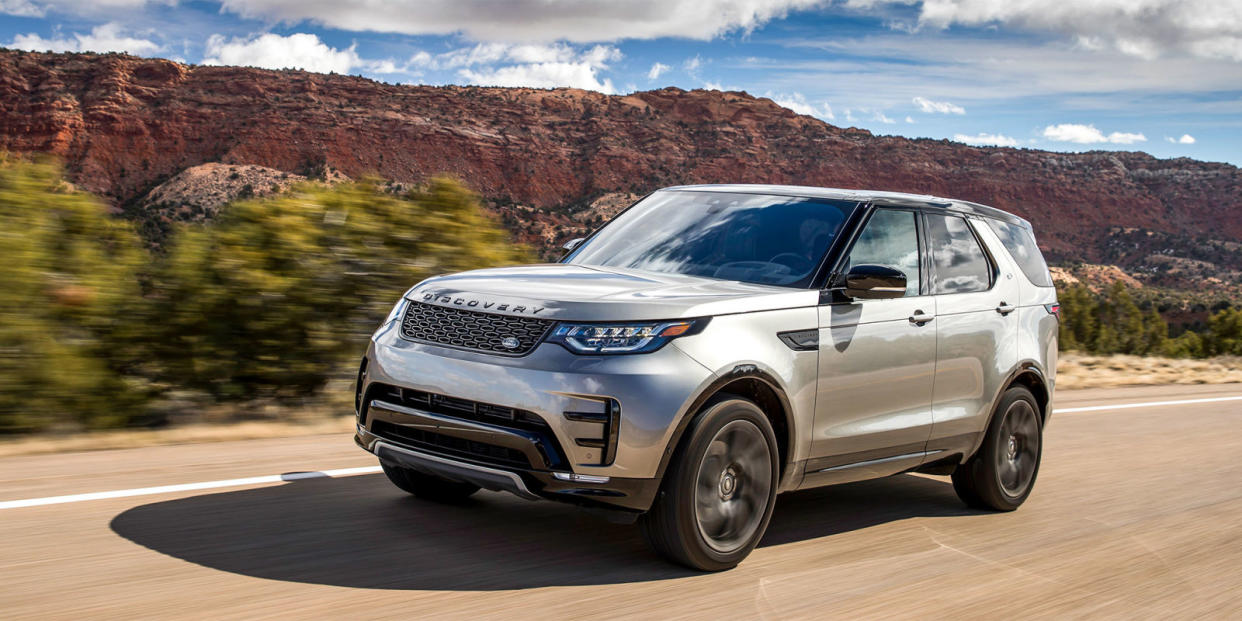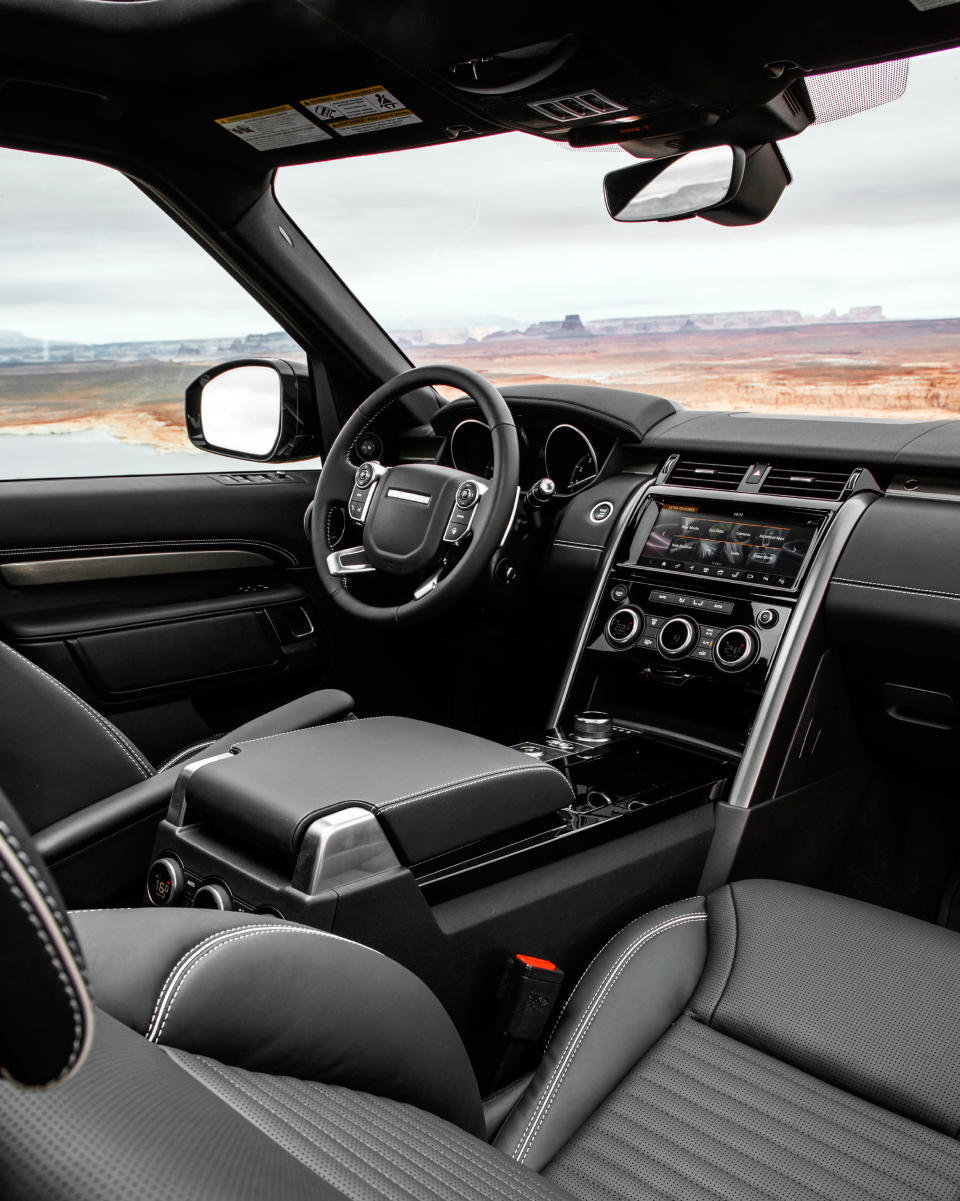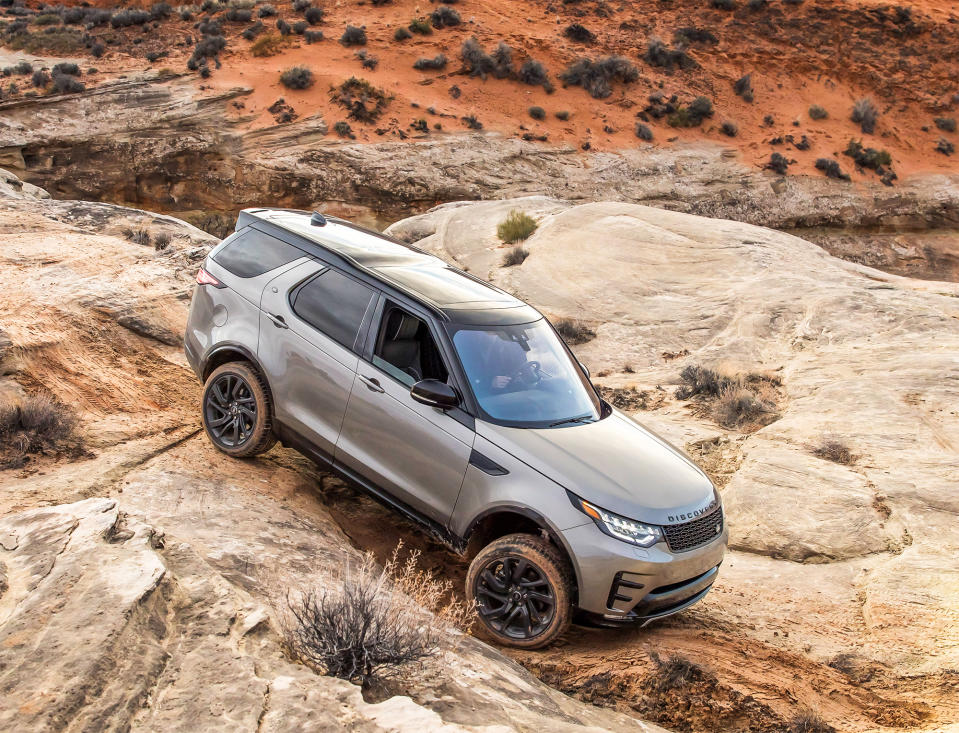First Drive: 2017 Land Rover Discovery HSE


CAN YOU APPEAL to the masses without pandering? How do you bring an acquired taste into the
mainstream? Does buying in mean selling out? Vexing questions. Ones I couldn't help asking as the all-new Land Rover Discovery HSE tetered on three wheels, halfway up a massive rock pile in the wilds of southern Utah, framed against a desert sunrise. This is everything I expected. Man enters machine, drives into a perfect landscape, rams said machine down Mother Nature's throat. Land Rover in a nutshell.
Except I wasn't driving.
Welcome to the world of semiautonomous off-roading, no Gore-Tex or pickax required.
Introductions come courtesy of All-Terrain Progress Control, which debuted in the flagship Range Rover last year. Here's how it works: The user presses a button, selects a speed up to 18 mph, then releases the brake. Gears churn. Forward progress begins. The truck feeds itself throttle, manipulates differential lockup, and pulsates each brake caliper, working very hard to maintain a modest pace. Pedals rise and fall, as if attached to a bewitched church organ. Tires slip and grab, axles hop and skip, all of their own volition. You steer. A little. Sometimes. The system is undeniably effective, incredibly clever, and, ultimately, pretty uninvolving once you're actually using it.
The Discovery in a nutshell.
What a shame. Twenty-eight years ago, the first Discovery, a ruggedly highbrow family truckster, launched to universal acclaim. Eventually becoming a cult icon, it spawned a single-make jungle-racing series, captivated the rural leisure class, and became a poster child for European overlanding culture. Because of that heritage, Land Rover stubbornly carried the same industrial design cues and body-on-frame construction through four generations. But each new Discovery was fatter and softer than the last, further upmarket and away from the truck's original mis-sion. Each also sold better than the last.
For this fifth generation, heritage goes out the window. The Discovery, which replaces the LR4, ditches the old steel ladder frame, moving on to the Range Rover Sport's thoroughly modern unibody structure. Gone are the cinder-block bodylines and upright windscreen, supplanted by a cohesive, corporate shape. The stepped roofline, a signature motif, has been smoothed into nonexistence.
A conventional liftgate replaces the quirky, horizontally split two-piece hatch. Exterior designer Massimo Frascella does not share his predecessors' sentimentality.
"It had to be a radical departure. This was not a matter of evolution, but really breaking away," he said. "The world has changed. The social landscape has changed. Customer expectations have changed. We wanted the Discovery to be relevant again. We want to expand our business."

Land Rover purists are going to have a cow, but results are results. The Discovery is five and a half inches longer and more than three inches wider than the LR4 but, thanks to the overhauled aesthetic, it looks no bigger in person. Twelve million hours of computer testing, including extensive wind-tunnel analysis, has resulted in an 11 percent better drag coefficient. Unsurprisingly, the new chassis, 85 percent aluminum, is claimed to be drastically stiffer and lighter. Other weight sayings include the use of magnesium for the front-end bracing and a composite for the new, single-piece liftgate. Engineers tell us the 2017 model is some 800 pounds lighter, depending on trim level. EPA combined fuel economy is up from 16 mpg to 18 mpg for the gas V-6. The 0–60-mph time should fall by nearly a second.
On the road, it's an even bigger step forward than those numbers suggest. The LR4, three tons and two stories tall, hanlles like a frisky mining cart, keeling and swaying on twisty roads. As for the Discovery, imagine a shrunken-head Range Rover. The electrically assisted steering feels floaty off-center but is surprisingly quick and honest. Sightlines are excellent, the brakes are rock solid, and the Discovery's body control is impressive, given its size. Ride quality is remarkably good; wind and tire noise hardly register. Overall, this is a far more civilized truck than the one it replaces.
It's more usable, too. As before, five-and seven-seat configurations are available the latter employing a stadium-style third row. Unlike before, that bench is power-folding; legroom is suitable for people with legs, headroom for those with heads. Smart packaging throughout allows a load capacity of more than 82 cubic feet with the rear seats folded, besting the Toyota Land Cruiser. Other focus-group pleasers include loads of tech and storage cubbies. Previous concerns about build quality have largely been addressed. Save for some questionable use of piano black trim, the cockpit oozes top-shelf confidence, all soft leathers and detailed instrumentation and tactile switchgear.
Still, some of the LR4's less endearing qualities remain. Namely the base engine, a supercharged V-6, which the Discovery inherits unchanged. The 3.0-liter seems happier in this lighter application but makes strained, unflattering noises and lacks the smoothness of German competitors. Despite offering a healthy 340 hp and 332 lb-ft torque and a righteous 8201-pound towing capacity, it's a letdown at this price point.
Good thing there's a diesel option. Fork over an extra $2000, and you'll get the same robust turbocharged 3.0-liter found in the Range Rover Td6. While peak output falls to 254 hp, torque jumps to 443 lb-ft. That chugging, mulish competency recalls the purpose-built vibe of Land Rovers past. Mated to an eight-speed ZF automatic, the oil burner returns 23 mpg combined, according to the EPA. It also provides the just-off-idle thrust you want when clambering over rocks.
Consider the HSE's standard kit: four-wheel drive, air suspension, hill-climb and descent assists, an electronic-locking center differential, a tactical front skid plate, and Land Rover's formidable off-road technology suite. There are settings for snow, mud, and sand, plus a rock-crawl mode, which adjusts brake hold 100 times per second at each wheel to optimize traction. Front double wishbones, in aluminum, come from the Range Rover. To accommodate a full-size underbody spare tire, engineers opted for a compact independent rear suspension and a heavy-duty steel subframe out back. A rear locker and two-speed transfer case, which allows rolling low-gear engagment under 38 mph, are both optional.
For the hard-core crowd, all this allows 19.7 inches of total wheel articulation, a 35.4-inch wading depth, and 11.1 inches of ground clearance across a 115.1-inch wheelbase, dictating a 25.5-degree breakover angle, with approach and departure angles of 29.5 and 28.0 degrees, respectively. For the layman, all this allows you to rest assured. Were the Discovery any more qualified to be off-road, it'd have camouflage, Caterpillar tracks, and a howitzer on the roof.

Dirt roads, washboard trails, a snowy mountain pass-everything Utah Canyon Country could muster, plus an afternoon plowing across sand dunes at the Arizona border. The truck took its licks, yawned, then asked for another. Predictably, the limiting factor in muddy conditions was the factory tire, a Goodyear Eagle all-season, rubber-banded around 20-inch wheels. The compound is agreeable enough over tarmac but easily overwhelmed on a malleable surface. You're often left dragging those rubber pelts around, relying on the Discovery's raw capability and expert calibration to pick up the slack.
Which they do. Which only make the capability and calibration seem more impressive.
Can you fault on-road-biased tires on a $60,000 people hauler? I can't. Really, I can't fault anything here.
Land Rover iconography is full of shotgun-wielding game wardens, Zambian safaris, and reading Kipling under the stars. Charming notions, and good for marketing, but an irrelevant approach to building automobiles in modernity. British manufacturers have a long history of resisting progress, often in spite of their own self-interest. We know that way lies madness. Also bankruptcy.
Right now, moneyed suburbanites want high-riding, tech-laden, seven-passenger truck approximates. Land Rover has delivered something for them, a product better than the one it replaces by every objective measure. The lone casualty is charisma. Maybe that alienates a small, loyal group of traditionalists. Land Rover predicts 90 percent of buyers, droves of semiautonomous off-roaders, will be new to the brand anyway. More telling still, the company expects premium sport-utility sales, up 40 percent over the past decade, to grow another 20 percent during the next.
Selling out? This is the new gold rush. Forget the pickax. The Discovery is dynamite.
You Might Also Like

 Yahoo News
Yahoo News 
